An MHD Marangoni Boundary Layer Flow and Heat Transfer with Mass Transpiration and Radiation: An Analytical Study
Abstract
:1. Introduction
2. Physical Model
3. Exact Analytical Solutions
3.1. Velocity
3.2. Temperature Distribution
4. Results and Discussion
5. Concluding Remarks
- The axial velocity declines with increasing porous parameter or magnetic field, and the suction/injection parameter increases with increasing Brinkman ratio.
- The temperature distribution increases for higher values of the porous parameter, magnetic field, or radiation; it decreases with an increase in the Brinkman ratio or suction/injection parameter.
- At , the axial velocity is different for various values of each parameter.
- The axial velocity is smaller for hybrid nanofluid than for base fluid.
- is the same for every value of varying parameters at .
- As the thermal rate increases upon adding nanoparticles to the base fluid, the figures showed that will be larger for hybrid nanofluid than for base fluid.
Author Contributions
Funding
Data Availability Statement
Conflicts of Interest
Nomenclature
| Symbol | Explanation | SI unit |
| Latin symbols | ||
| applied magnetic field | ||
| specific heat at constant pressure | ||
| inverse Darcy number | ||
| f | similarity variable | |
| mean absorption coefficient | ||
| K | permeability of porous medium | |
| Pr | Prandtl number | |
| radiative heat flux | ||
| local heat flux at the wall | ||
| magnetic parameter | ||
| radiation parameter | ||
| local Nusselt number | ||
| T | temperature | |
| suction/injection velocity | ||
| coordinate axes | ||
| velocities along x- and y-directions | ||
| Greek symbols | ||
| α | thermal diffusivity | |
| gamma function | ||
| thermal conductivity of fluid | ||
| η | similarity variable | |
| dynamic viscosity of fluid | ||
| effective viscosity | ||
| kinematic viscosity | ||
| density | ||
| electrical conductivity | ||
| Stefan–Boltzmann constant | ||
| nanoparticle volume fraction | ||
| stream function | ||
| Brinkman ratio | ||
| Subscripts | ||
| base fluid | ||
| nanofluid | ||
| Abbreviations | ||
| BCs | boundary conditions | |
| BLF | boundary layer flow | |
| MHD | magnetohydrodynamics | |
| HNF | hybrid nanofluid | |
| copper | ||
| aluminum oxide | ||
References
- Crane, L.J. Flow past a stretching plate. Z. Angew. Math. Phys. 1970, 21, 645–647. [Google Scholar] [CrossRef]
- Wang, C.W. The three-dimensional flow due to a stretching flat surface. Phys. Fluids 1984, 27, 1915–1917. [Google Scholar] [CrossRef]
- Rosca, A.V.; Pop, I. Flow and heat transfer over a vertical permeablestretching/shrinking sheet with a second order slip. Int. J. Heat Mass Transf. 2013, 60, 355–364. [Google Scholar] [CrossRef]
- Nandy, S.K.; Mahapatra, T.R. Effects of slip and heat generation/absorptionon MHD stagnation flow of nanofluid past a stretching/shrinking surface withconvective boundary conditions. Int. J. Heat Mass Transf. 2013, 64, 1091–1100. [Google Scholar] [CrossRef]
- Kumaran, V.; Banerjee, A.K.; Vanav Kumar, A.; Pop, I. Unsteady MHD flow and heat transfer with viscous dissipation past a stretching sheet. Int. Commun. Heat Mass Transf. 2011, 38, 335–339. [Google Scholar] [CrossRef]
- Turkyilmazoglu, M. Multiple solutions of heat and mass transfer of MHD slip flow for the viscoelastic fluid over a stretching sheet. Int. J. Therm. Sci. 2011, 50, 2264–2276. [Google Scholar] [CrossRef]
- Ishak, A.; Nazar, R.; Pop, I. Unsteady mixed convection boundary layer flowdue to a stretching vertical surface. Arab. J. Sci. Eng. 2006, 31, 165–182. [Google Scholar]
- Ishak, A.; Nazar, R.; Pop, I. MHD boundary-layer flow due to a movingextensible surface. J. Eng. Math. 2008, 62, 23–33. [Google Scholar] [CrossRef]
- Ishak, A.; Nazar, R.; Pop, I. Magnetohydrodynamic (MHD) flow and heattransfer due to a stretching cylinder. Energy Convers. Manag. 2008, 49, 3265–3269. [Google Scholar] [CrossRef]
- Yacob, N.A.; Ishak, A.; Pop, I.; Vajravelu, K. Boundary layer flow past astretching/shrinking surface beneath an external uniform shear flow with aconvective surface boundary condition in a nanofluid. Nanoscale Res. Lett. 2011, 6, 314. [Google Scholar] [CrossRef] [Green Version]
- Choi, S.U.S. Enhancing Thermal Conductivity of Fluids with Nanoparticles. In Developments and Applications of Non-Newtonian Flows; Siginer, D.A., Wang, H.P., Eds.; ASME: New York, NY, USA, 1995; pp. 99–105. [Google Scholar]
- Mahabaleshwar, U.S.; Anusha, T.; Sakanaka, P.H. Suvanjan Bhattacharyya, Impact of inclined Lorentz force and Schmidt number on chemically reactive Newtonian fluid flow on a stretchable surface when Stefan blowing and thermal radiation are significant. Arab. J. Sci. Eng. 2021, 46, 12427–12443. [Google Scholar] [CrossRef]
- Mahabaleshwar, U.S.; Lorenzini, G. Combined effect of heat source/sink and stress work on MHD Newtonian fluid flow over a stretching porous sheet. Int. J. Heat Technol. 2017, 35, S330–S335. [Google Scholar] [CrossRef]
- Aly, E.H.; Pop, I. MHD flow and heat transfer near stagnation point over a stretching/shrinking surface with partial slip and viscous dissipation: Hybrid nanofluid versus nanofluid. Powder Technol. 2020, 367, 192–205. [Google Scholar] [CrossRef]
- Sarpakaya, T. Flow of non-Newtonian fluids in a magnetic field. AIChEJ 1961, 7, 324–328. [Google Scholar] [CrossRef]
- Mahabaleshwar, U.S. Combined effect of temperature and gravity modulations on the onset of magneto-convection in weak electrically conducting micropolar liquids. Int. J. Eng. Sci. 2007, 45, 525–540. [Google Scholar] [CrossRef]
- Mahabaleshwar, U.S.; Vinay kumar, P.N.; Sakanaka, P.H.; Lorenzini, G. An MHD effect on a Newtonian fluid flow due to a superlinear stretching sheet. J. Eng. Thermophys. 2018, 27, 501–506. [Google Scholar]
- Fang, T.; Zhang, J. Closed-form exact solutions of MHD viscous flow over a shrinking sheet. Commun. Nonlinear Sci. Numer. Simul. 2009, 14, 2853–2857. [Google Scholar] [CrossRef]
- Hamad, M.A.A. Analytical solution of natural convection flow of a nanofluid over a linearly stretching sheet in the presence of magnetic field. Int. Commun. Heat Mass Transf. 2011, 38, 487–492. [Google Scholar] [CrossRef]
- Turkyilmazoglu, M. Multiple analytic solutions of heat and mass transfer of magnetohydrodynamic slip flow for two types of viscoelastic fluids over a stretching surface. J. Heat Transf. 2012, 134, 071701. [Google Scholar] [CrossRef]
- Suresh, S.; Venkitaraj, K.; Selvakumar, P.; Chandrasekar, M. Effect of Al2O3–Cu/water hybrid nanofluid in heat transfer. Exp. Therm. Fluid Sci. 2012, 38, 54–60. [Google Scholar] [CrossRef]
- Suresh, S.; Venkitaraj, K.; Selvakumar, P.; Chandrasekar, M. Synthesis of Al2O3–Cu/water hybrid nanofluids using two step method and its thermo physical properties. Colloids Surf. A 2011, 388, 41–48. [Google Scholar] [CrossRef]
- Vinay Kumar, P.N.; Mahabaleshwar, U.S.; Nagaraju, K.R.; MousaviNezhad, M.; Daneshkhah, A. Mass transpiration in magneto-hydrodynamic boundary layer flow over a superlinear stretching sheet embedded in porous medium with slip. J. Porous Media 2019, 22, 1015–1025. [Google Scholar] [CrossRef]
- AmiraZainal, N.; RoslindaNazar, R.; Naganthran, K.; Pop, I. Stability analysis of MHD hybrid nanofluid flow over a stretching/shrinking sheet with quadratic velocity. Alex. Eng. J. 2020, 60, 915–926. [Google Scholar]
- Khan, U.; Shafiq, A.; Zaib, A.; Baleanu, D. Hybrid nanofluid on mixed convective radiative flow from an irregular variably thick moving surface with convex and concave effects. Case Stud. Therm. Eng. 2020, 21, 100660. [Google Scholar] [CrossRef]
- Sarkar, J.; Ghosh, P.; Adil, A. A review on hybrid nanofluids: Recent research, development and applications. Renew. Sustain. Energy Rev. 2015, 43, 164–177. [Google Scholar] [CrossRef]
- Aly, E.H.; Ebaid, A. Exact analysis for the effect of heat transfer on MHD and radiation Marangoni boundary layer nanofluid flow past a surface embedded in a porous medium. J. Mol. Liq. 2016, 215, 625–639. [Google Scholar] [CrossRef]
- Mahabaleshwar, U.S.; Nagaraju, K.R.; Vinay Kumar, P.N.; Azese, M.N. Effect of radiation on thermosolutal Marangoni convection in a porous medium with chemical reaction and heat source/sink. Phys. Fluids 2020, 32, 1136902. [Google Scholar] [CrossRef]
- Napolitano, L.G. Marangoni boundary layers. In Proceedings of the 3rd European Symposium on Material Science in Space, Grenoble, France, 24–27 April 1979. [Google Scholar]
- Chamkha, A.J.; Pop, I.; Takhar, H.S. Marangoni mixed convection boundary layer flow. Meccanica 2006, 41, 219–232. [Google Scholar] [CrossRef]
- Cortell, R. Radiation effects for the Blasius and Sakiadis flows with a convective surface boundary condition. Appl. Math. Comput. 2008, 206, 832–840. [Google Scholar]
- Mahabaleshwar, U.S.; Sarris, I.E.; Hill, A.A.; Lorenzini, G.; Pop, I. An MHD couple stress fluid due to a perforated sheet undergoing linear stretching with heat transfer. IJHM 2017, 105, 157–167. [Google Scholar] [CrossRef] [Green Version]
- Mahabaleshwar, U.S.; Nagaraju, K.R.; Vinay Kumar, P.N.; Nadagoud, M.N.; Bennacer, R.; Sheremet, M.A. Effects of Dufour and Soret mechanisms on MHD mixed convective-radiation non-Newtonian liquid flow and heat transfer over a porous sheet. Therm. Sci. Eng. Prog. 2019, 16, 100459. [Google Scholar] [CrossRef]
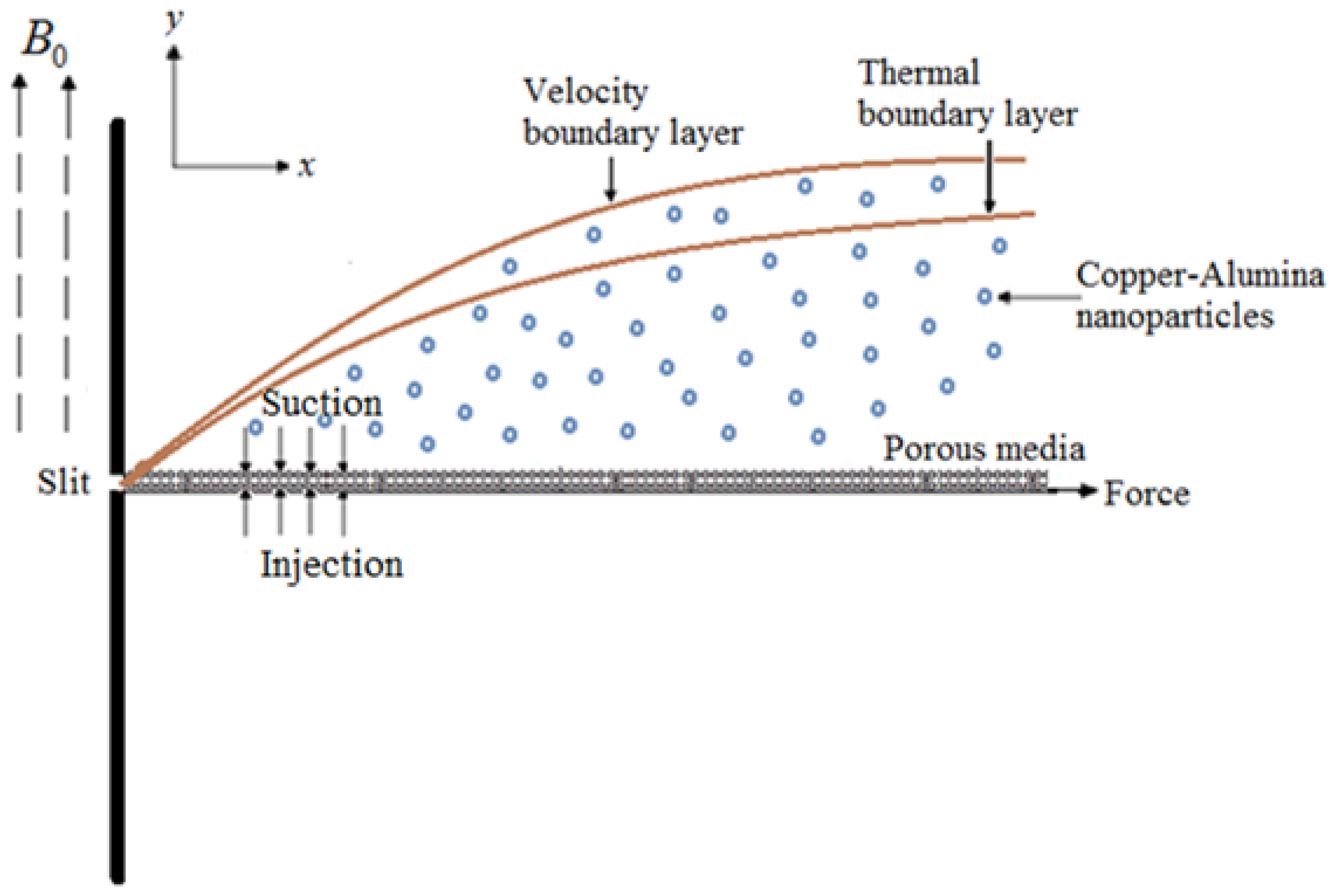
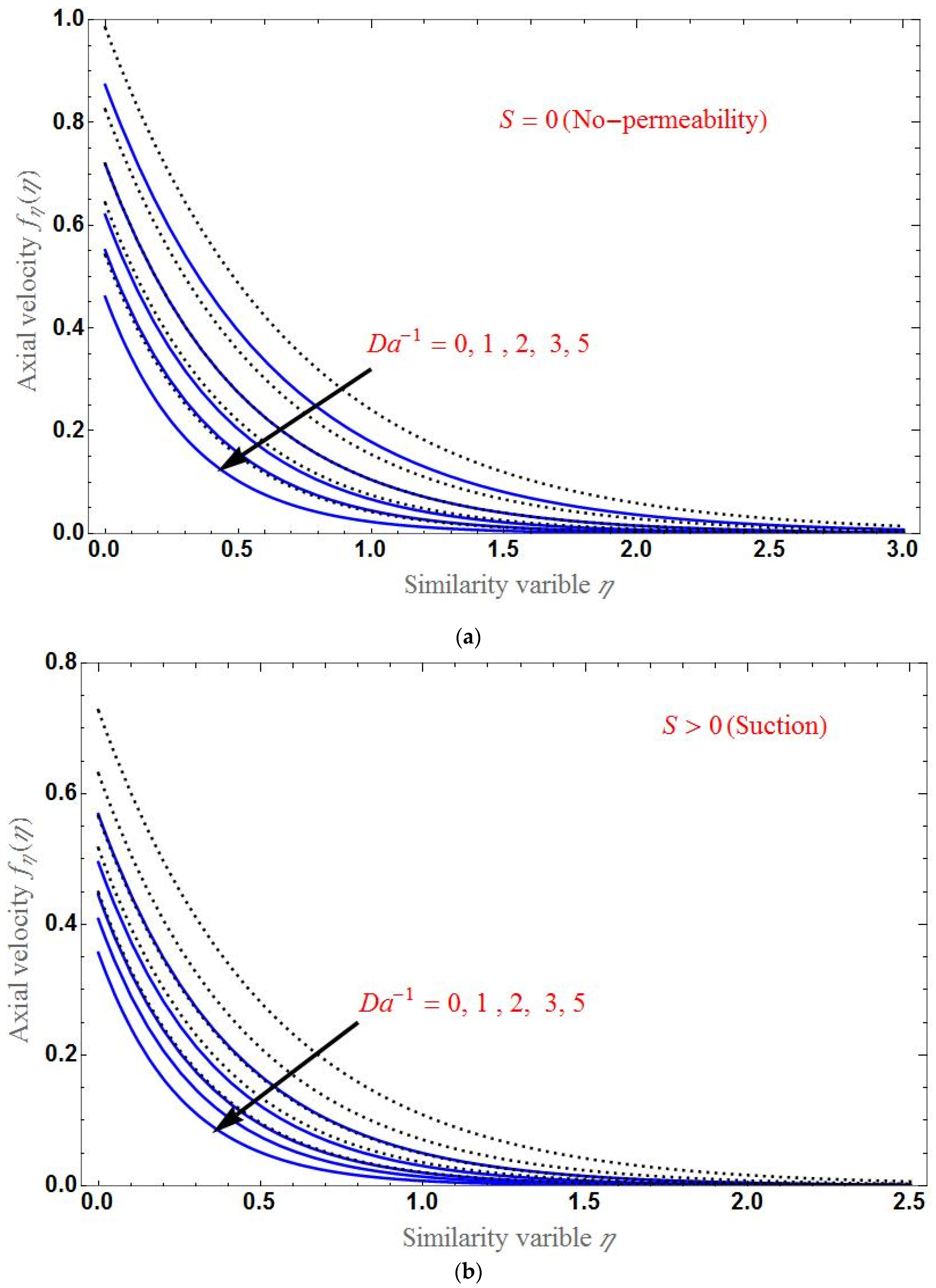

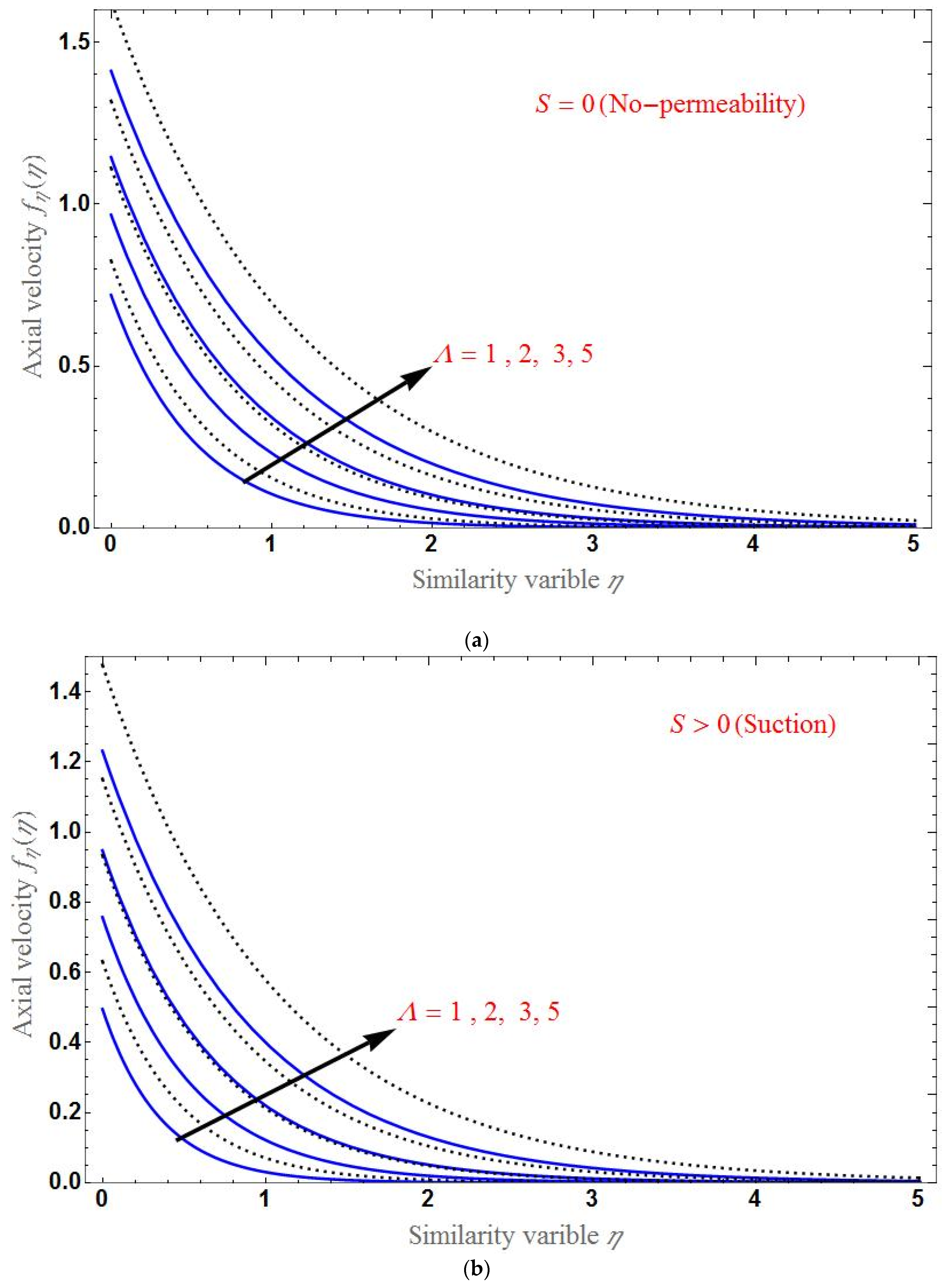

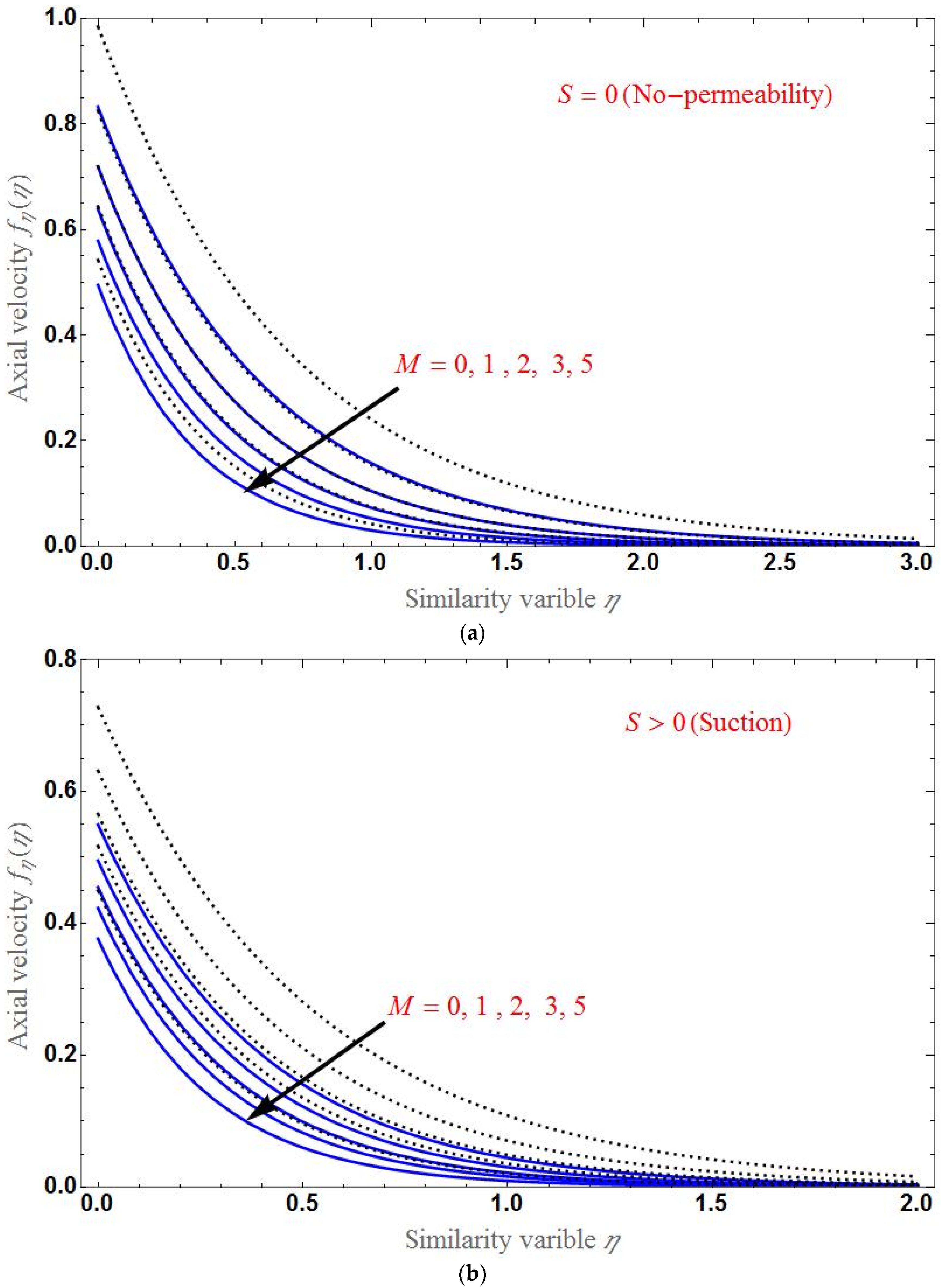

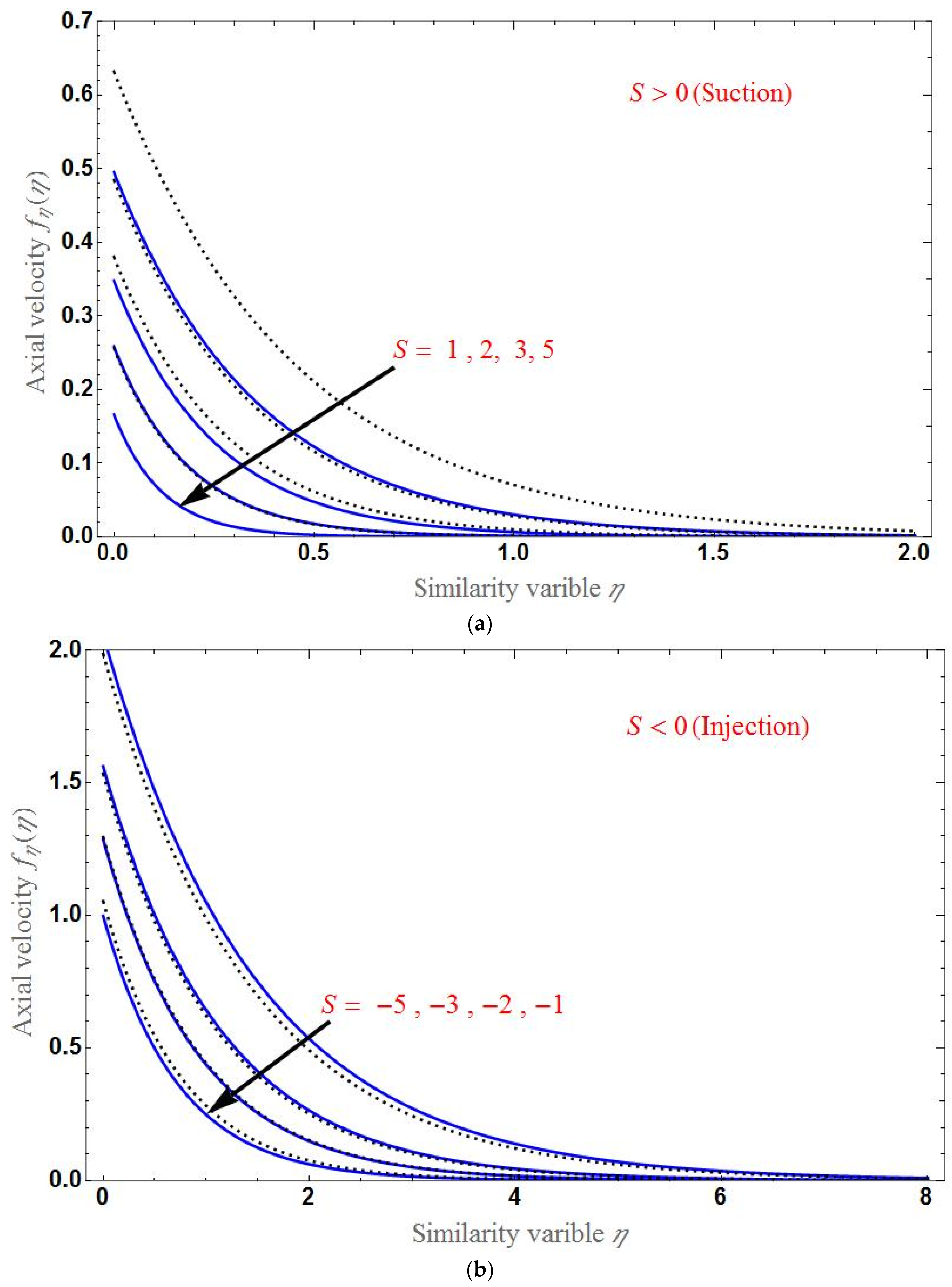

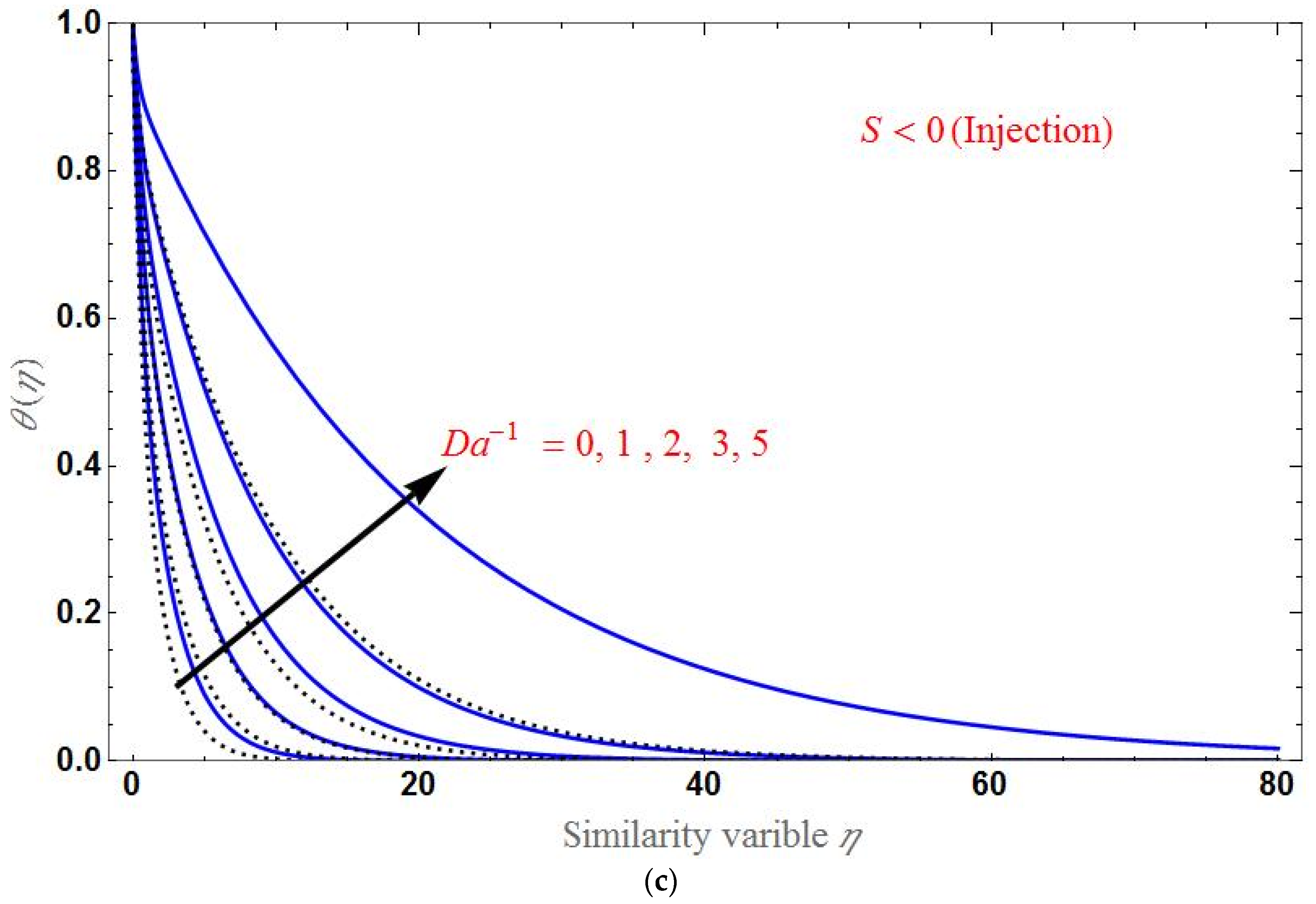
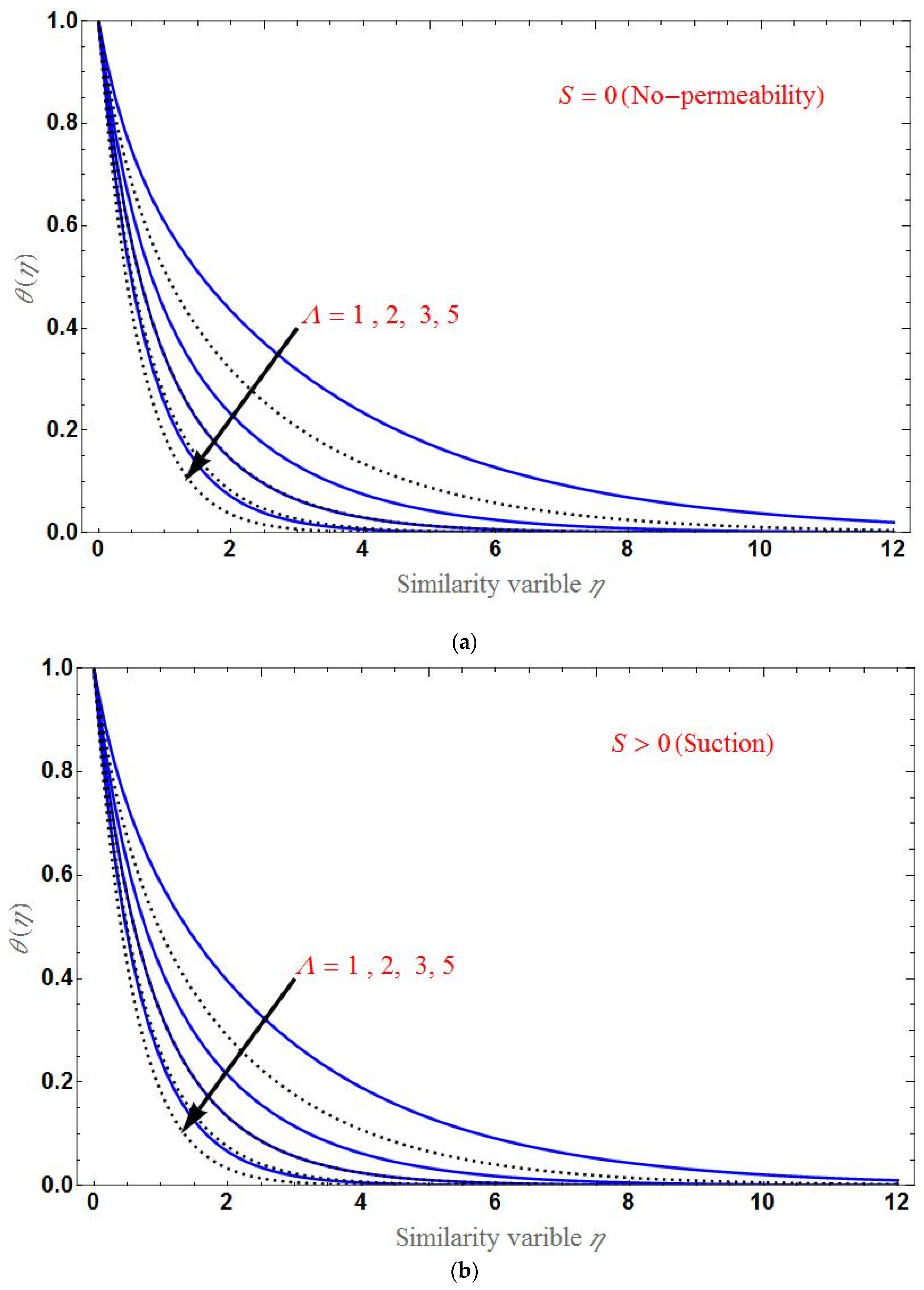
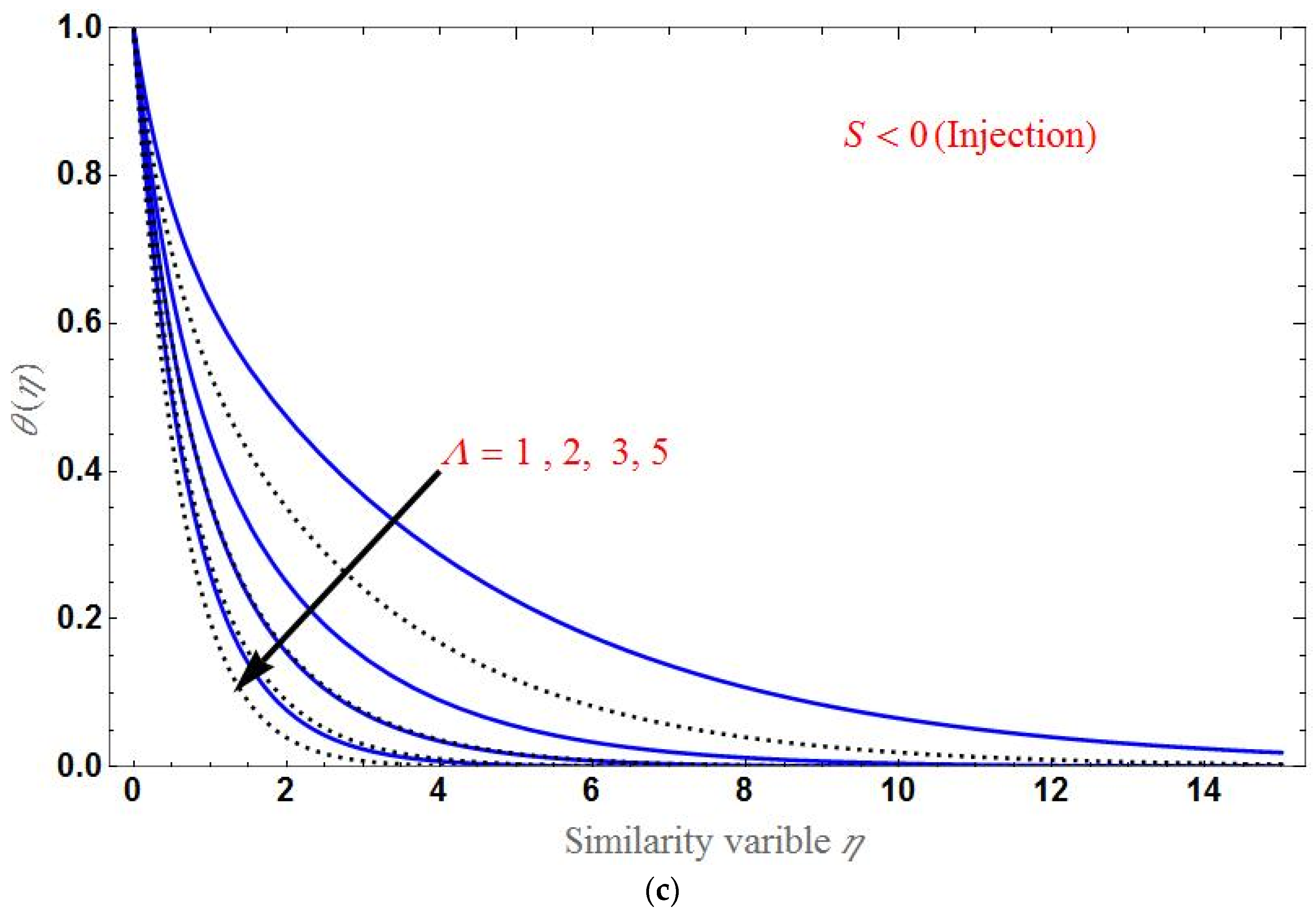
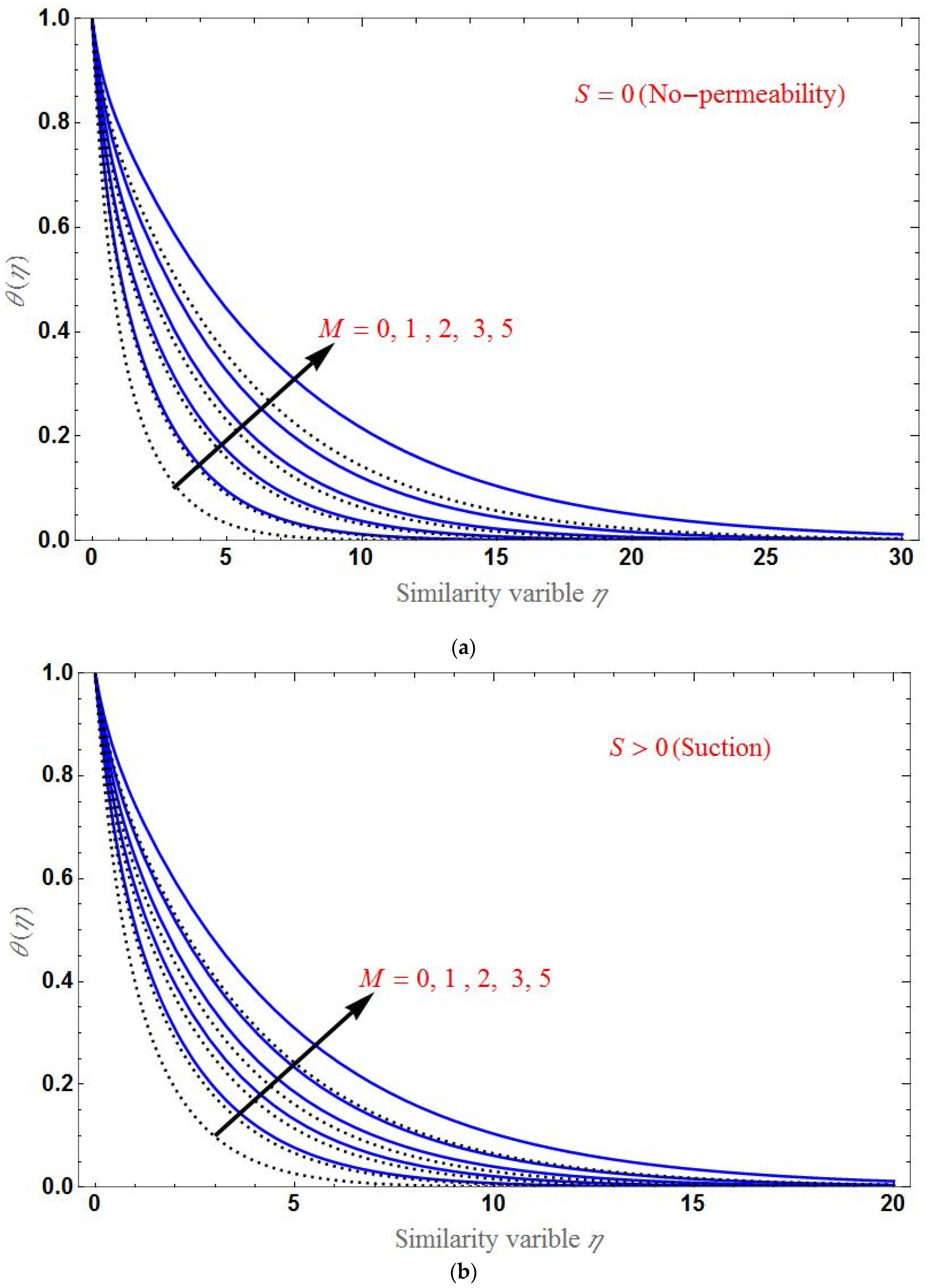

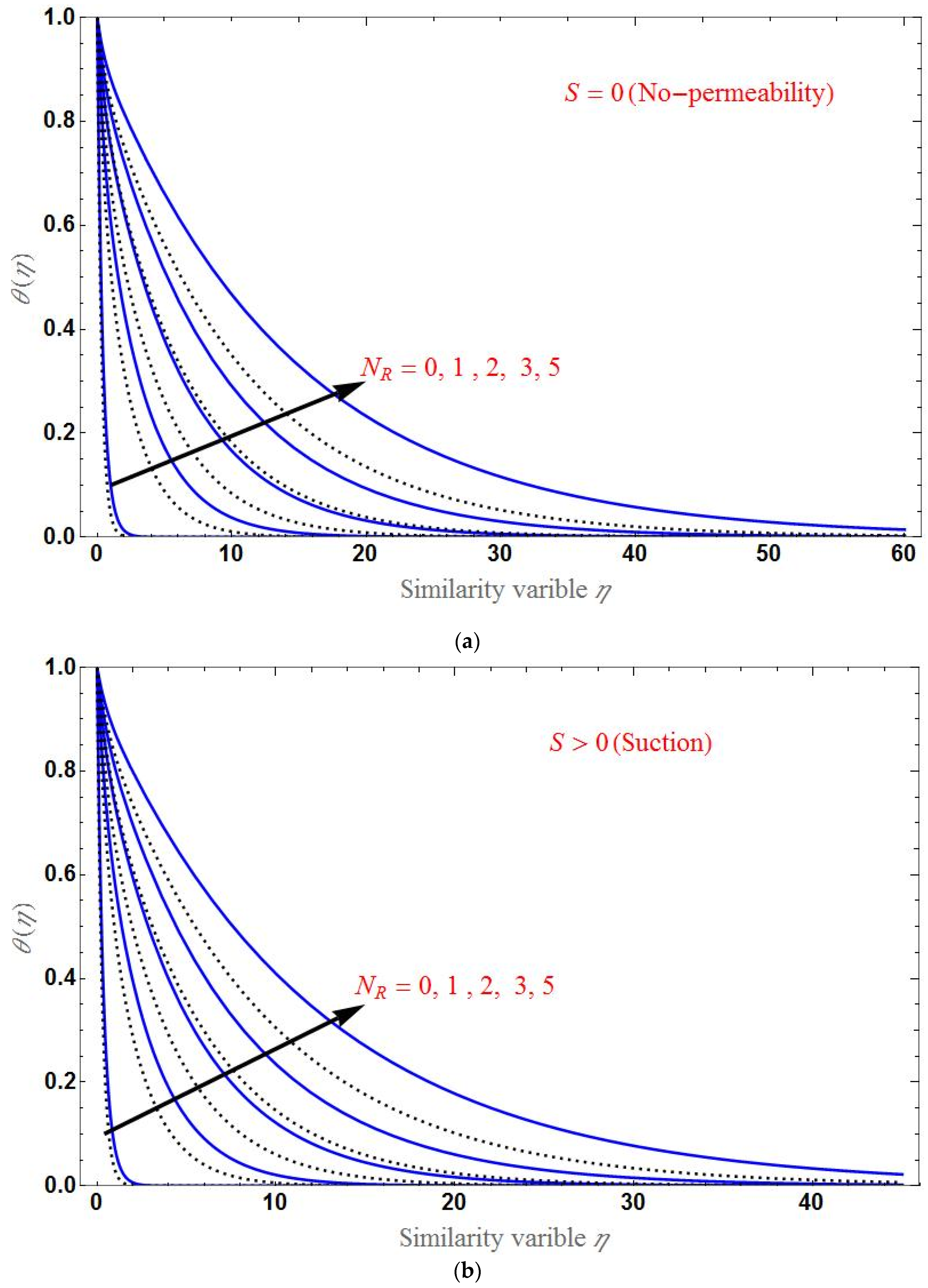
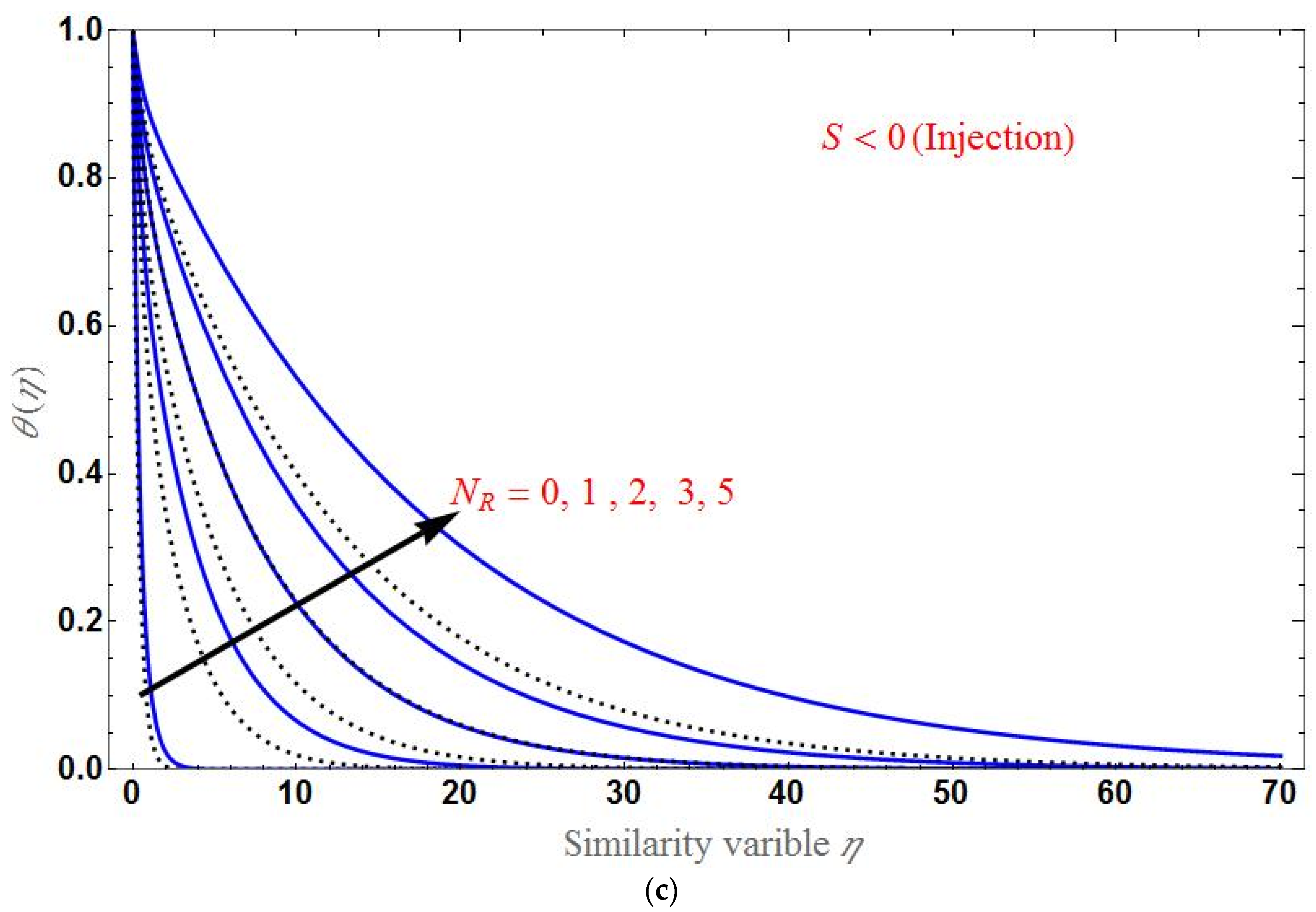
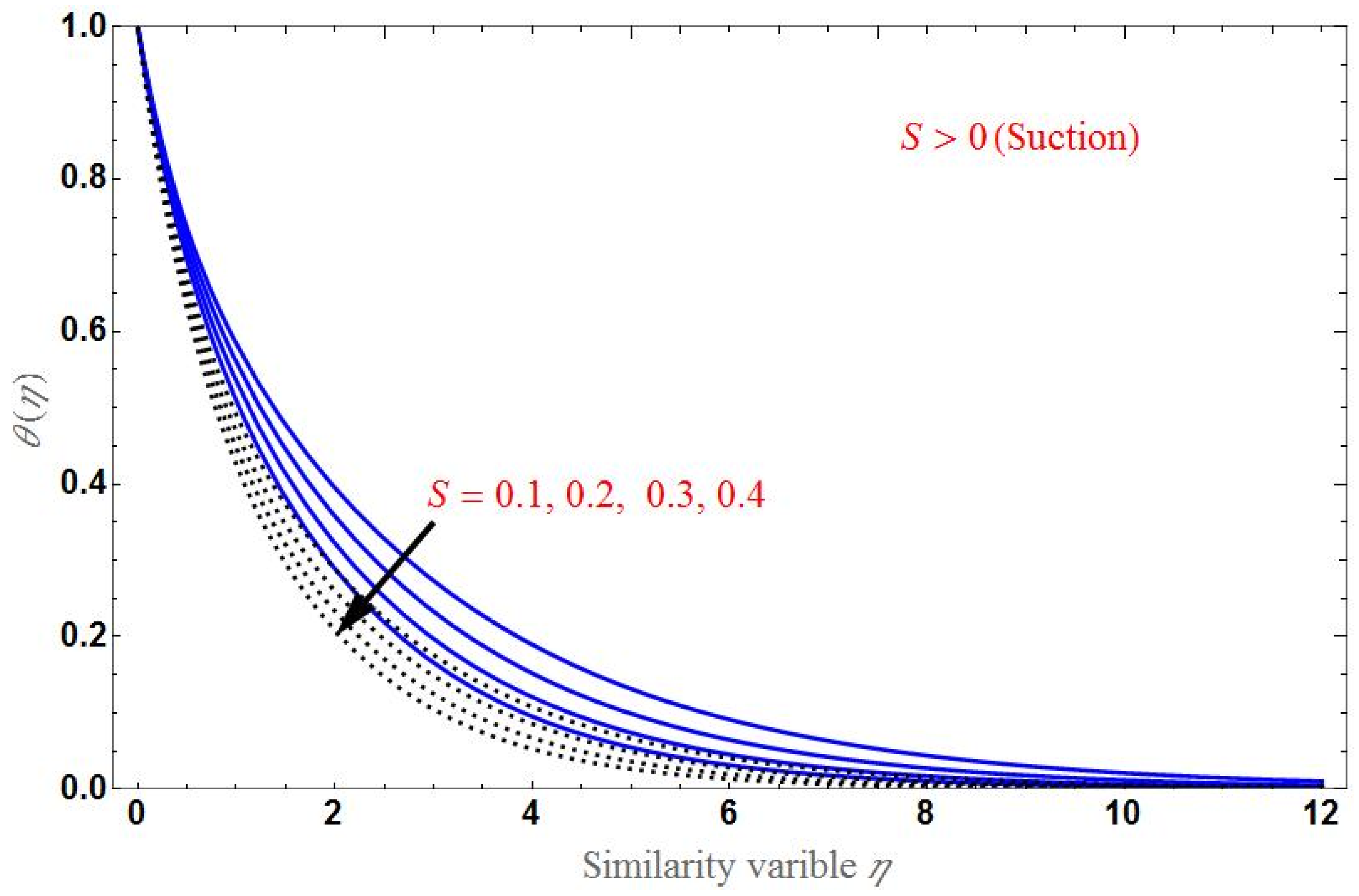

Publisher’s Note: MDPI stays neutral with regard to jurisdictional claims in published maps and institutional affiliations. |
© 2022 by the authors. Licensee MDPI, Basel, Switzerland. This article is an open access article distributed under the terms and conditions of the Creative Commons Attribution (CC BY) license (https://creativecommons.org/licenses/by/4.0/).
Share and Cite
Anusha, T.; Mahesh, R.; Mahabaleshwar, U.S.; Laroze, D. An MHD Marangoni Boundary Layer Flow and Heat Transfer with Mass Transpiration and Radiation: An Analytical Study. Appl. Sci. 2022, 12, 7527. https://doi.org/10.3390/app12157527
Anusha T, Mahesh R, Mahabaleshwar US, Laroze D. An MHD Marangoni Boundary Layer Flow and Heat Transfer with Mass Transpiration and Radiation: An Analytical Study. Applied Sciences. 2022; 12(15):7527. https://doi.org/10.3390/app12157527
Chicago/Turabian StyleAnusha, Thippeswamy, Rudraiah Mahesh, Ulavathi Shettar Mahabaleshwar, and David Laroze. 2022. "An MHD Marangoni Boundary Layer Flow and Heat Transfer with Mass Transpiration and Radiation: An Analytical Study" Applied Sciences 12, no. 15: 7527. https://doi.org/10.3390/app12157527
APA StyleAnusha, T., Mahesh, R., Mahabaleshwar, U. S., & Laroze, D. (2022). An MHD Marangoni Boundary Layer Flow and Heat Transfer with Mass Transpiration and Radiation: An Analytical Study. Applied Sciences, 12(15), 7527. https://doi.org/10.3390/app12157527





